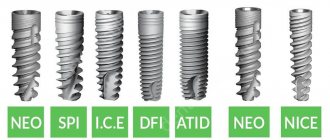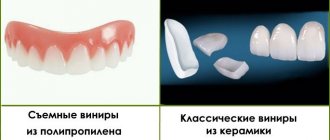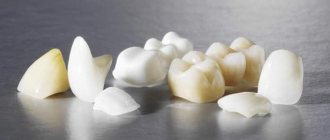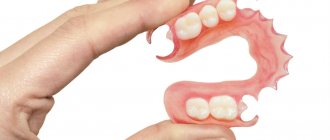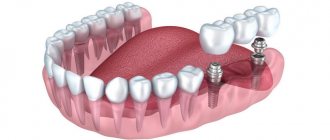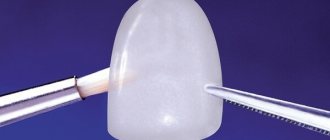Veneers What to do?
Lumineers Ultraneers Composite onlays Crowns Inlays Decorative onlays Doctors Work Dental onlays are orthopedic mini-prostheses used to restore the aesthetics of the dentition. Dental restoration is usually carried out:
- for medical reasons (treatment, prevention of dental diseases, reconstruction of lost teeth);
- in order to restore the aesthetics of a smile.
To satisfy these needs, there are many ways in which dental restoration with onlays is carried out. In this article we will look at the most popular of them.
Composite onlays for teeth
Therapeutic, or composite, onlays for teeth are used in cases where the goal is to build up a badly damaged tooth, and not just improve aesthetics. For example, they can be used in case of severe chipping of the incisor (more than half the area) or in other cases when orthopedic veneers are simply useless due to the impossibility of their installation. Such dental overlays are made using the direct method, that is, immediately on the patient’s tooth, from composite materials, hence their name – composite veneers. Therapeutic overlays have a standard color range, so in some cases the patient cannot choose the appropriate shade. The advantage of this type of onlay is that the patient receives a visible result in one visit; in addition, the price of onlays for teeth made of a composite is significantly lower than classic ceramic veneers.
Overlays for crooked teeth
In some cases, dental onlays can be used to correct minor defects in the dentition. These include veneers, as their thickness allows you to hide imperfections. Overlays on teeth that are too thin, such as lumineers and ultraneers, will not cope with this task. You can use onlays for leveling only if the patient has a correct bite - installing such onlays on the teeth to solve the problem of correcting the bite will not bring any effect. They are helping:
- camouflage crooked teeth;
- correct too short teeth;
- get rid of a gummy smile (the problem is solved in combination with gum surgery);
- give a lifting effect to the cheekbones (when installing onlays on chewing teeth).
If significant adjustments are required, it is better to opt for ceramic onlays for teeth, as they are reliable and aesthetically pleasing. Composite veneers can be used to correct minor defects. The price of such dental overlays is significantly lower than the cost of ceramic veneers.
In addition to veneers, if teeth are slightly crowded, crowns can also be used - they help correct the curvature of one or more teeth. The disadvantage of this method of installing onlays on crooked teeth is the need to prepare healthy dental tissues, which not every patient will do. This method is considered quite aggressive. The advantages include quick results, in contrast to using a braces system.
Contraindications for use
If we take into account all the indications and the location of the installation, then the contraindications look like this:
- the natural crown is destroyed by more than half,
- the “nerve” has long been removed from the roots: in this case, the microprosthesis can last much less than the stated period,
- periodontitis, cysts or granulomas are found at the roots: without treatment, the pathology will continue to develop, which will inevitably lead to the need to remove the onlay and treat the periodontium/bone,
- if restoration of incisors or canines is required.
Teeth onlays to correct bite
If the patient has no complaints about the enamel and is only interested in correcting crowded teeth, the doctor may suggest treatment with special mouthguards or aligners. Unlike fixed orthodontic structures, they can be removed during meals and during oral hygiene procedures. They are practically invisible on the teeth, as they are made of transparent material. Due to their tight fit to the dentition, removable onlays promote gradual teeth alignment. The disadvantage of treatment with mouthguards is their limited effect. If you have a complex case, then it is better to opt for aligners, which are as effective as braces.
Indications for use
- chips of the dental crown are less than 50% - that is, the side walls must remain so that the inlay can be secured. If they are not there, i.e. the crown is destroyed at the root, it is necessary to consider the stump tab,
- restoration of a natural crown after massive drilling of enamel and dentin in the treatment of caries, when the installation of a composite filling is unreliable,
- replacing old fillings with more reliable and durable solutions,
- thin tooth walls and the large cavity they surround,
- increased sensitivity to chemical and thermal irritants: cold, hot, sour, sweet.
Aesthetic onlays for teeth
By “Hollywood” we mean a snow-white, even smile, which is associated with the smiles of movie stars - the generally accepted standard is four front teeth that are level with each other. In this case, the teeth must be large enough. In Russia, this concept simply means straight and white teeth. A similar result can be achieved in various ways. If, due to aesthetic defects, increased sensitivity or slight curvature of teeth, it is not possible to limit yourself to minimally invasive procedures, then cosmetic dental veneers are used. In aesthetic dentistry the following are used: veneers, ultraneers, compositers and lumineers. All of these types of aesthetic dental onlays are made in a dental laboratory using individual impressions of the patient’s teeth and then attached to the enamel surface.
In order to improve the aesthetics of the dentition, including hiding minor defects in the surface of the teeth, ceramic dental veneers are most often used, since this material is closest to the natural tooth enamel. The peculiarity of installing such onlays on teeth is that the procedure requires preliminary grinding of the enamel to the thickness of the veneer (0.3 - 0.7 mm). In addition, vinyl overlays for teeth are often used today; they are somewhat inferior to ceramic veneers in terms of characteristics, but are more affordable in cost. The number of plates installed may vary depending on the width of the smile. In cases where the teeth are severely damaged (less than 10% of the tissue remains) or there is a slight curvature of the dentition, crowns are used to achieve a Hollywood smile.
To achieve maximum strength, veneers are made of zirconium dioxide or aluminum (only the frame is made of metal, and the upper crown is made of ceramic), but in this case, the onlays on the teeth do not transmit light as well, so upon close examination the difference may be noticeable. In this regard, it is worth making an informed decision: either ceramic veneers for 5–8 years, or zirconium veneers for 15–20 years.
Pros and cons of removable veneers
These products have both positive and negative qualities. Their positive qualities are as follows. Only they:
- cover the filed part of the tooth, reduce its sensitivity to temperature changes and other external negative factors;
- protect teeth from microtraumas that a person can receive while chewing food;
- make the smile more aesthetically pleasing and attractive;
- allow the patient to quickly see the result of their treatment and correct it in time.
In addition, these products have several disadvantages. Eg:
- Food or liquid can easily get under the device, and this often leads to the development of caries. That is why doctors do not recommend that patients delay visiting a specialist. He must quickly remove the temporary veneers and replace them with permanent ones;
- The installed veneer may crack or break off. This usually happens if a person eats solid foods frequently.
Remember: wearing removable veneers increases the final cost of prosthetics.
White teeth whitening pads
If the goal is only to change the shade of the enamel, dentistry uses the thinnest white overlays on teeth made of composite, as well as in the form of lumineers and ultraneers. Teeth whitening with onlays in this way is suitable only for those who have healthy enamel (or is slightly damaged). The lightening procedure itself using such plates is called restoration bleaching. It is used when traditional types of whitening, such as home, laser, oxygen and Zoom whitening, do not work. During installation, the onlays are attached to the facial surface of the front teeth. Whitening plates are not installed on chewing teeth.
If desired, the patient can always contact the doctor with a request to change the plates to new ones (of a different color) or remove them completely. Moreover, the cost of installing such onlays on teeth will be significantly lower compared to other types of restoration.
Dental crowns
If we are talking about crowns, this is a fairly voluminous restoration. Dental crowns are used to restore the anatomical shape of the tooth, chewing and speech functions, and create a beautiful aesthetic effect. A crown may be a necessary measure if the tooth’s nerve has been removed and a large amount of tissue is missing. It can also be installed on a living tooth to restore the original shape of the tooth and, as a result, the correct bite: the height of the tooth, the shape of the tubercles, the area of the chewing surface directly affect the bite and the health of the teeth in the future.
Types of dental crowns
Technique for installing onlays for restorative bleaching
Straight
– application of onlays on teeth made of composite material occurs directly on the enamel without preliminary production in the laboratory.
Indirect
– the thinnest (up to 0.3 mm) dental overlays are attached to the teeth – lumineers and ultraneers, pre-made in the laboratory individually based on a dental impression.
In addition to the listed methods, you can lighten the enamel by several shades using removable trays, which are used for whitening at home. They work due to a special whitening gel placed in the plate. You need to wear them for an average of an hour a day. But, unlike lumineers or composite veneers, it is not possible to accurately “predict” the result in advance, since it depends on the individual characteristics of the patient.
What are Tabs
Everyone knows what fillings and crowns are. But when a dentist offers such an option as dental inlays, many people do not understand what this means. Let's figure it out.
Inlays for a tooth crown (or, as they are also called, “onlays”) refer to microprosthetics when it comes to restoring a partially destroyed natural crown. Inlays are an alternative to large fillings and they are needed when, as a result of caries, the top of the tooth is severely destroyed, but it is too early to install a dental crown and cannot be restored with a filling. An inlay is literally a missing piece of tooth that is attached to the remaining walls.
REPROSTHETOSIS WITH ACRYLIC PROSTHETICS - RUB 180,000!
Re-prosthetics with an acrylic bridge on a metal frame (all included) up to 12 units.
Call now or request a call
Jewelry on teeth
When your teeth are healthy, but you still want your smile to attract even more attention from others, patients turn to aesthetic dentistry to have onlays placed on their teeth for beauty: skys and grills.
Skyes
– decorative overlays on teeth, which are used to decorate the enamel or camouflage a small defect. These can be gold and silver overlays for teeth, as well as platinum and combined ones - using crystal, Swarovski crystals and precious stones.
Skyce installation is carried out using two methods. The first involves attaching the onlay directly to the tooth: a depression is made on the surface of the tooth, and the stone is fixed in it using a composite material. But inlay is a rare occurrence in dentistry, since not everyone wants to have an extra hole in a healthy tooth. In the second case, microprosthetics is used: the skye is installed on an onlay (veneer), previously made from an impression, then the onlay is attached to the tooth surface using filling materials. Such dental overlays help hide more serious enamel defects.
Grillz
– removable dental onlays, which are installed on both one and several front teeth. They are popular among celebrities and are usually quite expensive because they are custom-made from precious metals. Silver, gold and platinum dental overlays can be encrusted with diamonds, emeralds and rubies. However, grillz do not necessarily have to be made of gold or other precious metals. They can be made from inexpensive metals with rhinestones and not individually, but according to a template. In this case, the price for such dental overlays will be more affordable.

